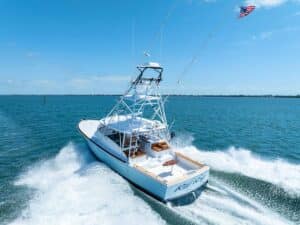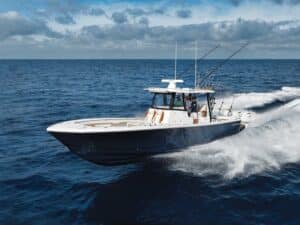
DIY Protection
I was recently happy to find an old friend, Pettit’s Splash Zone A-788, which got me home and saved our boat from a near sinking. It’s a two-part underwater epoxy repair kit that’s been rereleased in new packaging, and once again, I am carrying fresh kits for emergency repairs. I don’t like being caught off guard, but things happen at the worst times, and being prepared with the right tools to get you home is essential. The more time you spend on the water, the more things you like to have in your arsenal to keep you floating.
Back in the mid-’90s, my crew and I were on our way home from San Salvador, heading for Highbourne Cay with about 20 miles to go in the deep Exuma Sound, when we began to take on water. This near-disaster occurred at the end of our maiden trip on Brier Patch, a 1971 45-foot Rybovich, which was new to us at the time.
After a great trip to San Salvador, where we had enjoyed some good action, my friend and deckhand for the trip, Capt. Barry Robinson, and I headed for home. During the roughly 140-mile run to Highbourne Cay, the high-water alarm’s horrible sound pierced the air late in the afternoon. I slowed the boat and turned to Barry to hold the wheel as I ran below, hoping to find a stuck float switch.
I lifted the hatches and couldn’t see any water in the lazarette or in the engine room. Prematurely relieved and puzzled, I looked down the companionway below, and my heart sank as I saw the floor hatches start to float!
I pulled up the bilge hatches and discovered that a small, intermediate stringer underneath a bunk on the port side between the chine and the main stringer was cracked, and water was coming in from underneath at a fairly good clip. Further inspection revealed that the stringer had come loose from the bottom of the boat. We could not shed the incoming water fast enough, because the boat had been rigged at some point with the forward bilge pumps routed to a sump box for the shower. If you do the math, you know that a 500 gph sump pump could not possibly shed the water coming from two 1,500 gph pumps.
We kept a slow and steady course toward Highbourne Cay as I feverishly rerouted hoses into the sinks, which drained directly overboard, extending them with any jury-rigged stuff I could find. Luckily, for emergencies such as these, I carry a 110-volt submersible pool pump. With the washdown hose connected to the pump and running out to the cockpit, we could finally shed enough water to keep up with the flow.
Fortunately, we made it to Highbourne Cay just as the last glimmer of sunlight faded in the west. We must have been quite a sight on the dock, with several hoses running out of the salon into the cockpit, draining water. As soon as we tied up, I grabbed an underwater light and jumped overboard to take a look at the bottom. I found a long crack and hole from the head of a bolt that had been pushed and pulled in and out as the little stringer flexed with the bottom. This is when I learned a lot about underwater epoxy repair.
Plenty of folks on the dock offered up advice on what to do, and I became the guinea pig, completely grateful and willing to try anything that would potentially keep the boat afloat. I would have stuffed oatmeal in the hole if someone had said it would harden and get me home. I tried the epoxy sticks first.
The tootsie-roll version, with the hardener in the middle, disintegrated into a fine dust; it was like grinding fish chunks in your hands to feed the fish on a dive. The two-part epoxy sticks wouldn’t meld together underwater, so I came away with two clumps of useless putty that wouldn’t stick to itself, let alone the bottom of the boat. I even tried the instant-casting stuff for setting broken bones in an emergency. The cheesecloth material quickly shed its epoxy paste and wouldn’t stick either.
I finally got to two little pint cans with the Pettit logo on them. Each had a little bit of part A and part B epoxy remaining in them. Robinson mixed it with a putty knife on some cardboard, and I descended once again, hoping to start filling the hole and the length of the crack. Lo and behold, the stuff worked. I pushed it into the crack with my thumb, and it stuck. Knowing that I only had a small amount, I worked as fast as I could to fill the hole and work from there, as the crack grew smaller farther from the hole. I got back in the boat and noticed right away that the stream of incoming water had slowed a great deal.
The next morning, the pumps had kept up with the water, and there was just a slight seep coming from under the stringer. Another quick swim proved that the epoxy continued to stick as it hardened, and I wasn’t able to pull it away from the bottom. We cautiously chugged to Nassau, where I procured three more kits of Splash Zone epoxy, a section of plywood, some stainless nails and two tubes of 5200 to make a more secure repair.
The beauty of Splash Zone A-788 (pettitpaint.com) is its malleability, which makes it easy to mix with gloved hands or a putty knife. Jumping overboard once again, I smeared the Splash Zone epoxy onto the hole and crack. We then cut the plywood and smeared a bead around the edge. Taking the plywood under the boat, I placed it on the bottom over the damage and nailed around the edge to secure it. I squeezed a bead of 5200 around the outside edges in hopes that, while under way, it would help keep the plywood from separating. However, that proved unnecessary, as we had a hard time getting the plywood off the bottom since it was stuck on so well.
Pettit’s Splash Zone A-788 is an excellent lightweight, waterproof epoxy-fairing compound that bonds readily to wood, fiberglass, aluminum, steel, concrete, polyester resins and other epoxies. It excels in below-the-waterline repairs and is equally effective above the waterline. The epoxy cures fast, and it can be used for fairing or as a filler; once it’s dry, you can sand, drill or nail it.
Pettit also has two other products that are very useful on board, especially when traveling. FlexPoxy is a thick-formula, two-part epoxy that does not sag, run or shrink, and it can be tinted to match paints and stains. It can also be molded and shaped to conform to the surrounding area, and once cured, it maintains its elasticity above or below the waterline.
Pettit’s EZ-Fair is a lightweight, two-part fairing epoxy designed to smooth surface imperfections above or below the waterline, making it an excellent putty for osmotic blister and gouge repair. It adheres to fiberglass, wood, metal and most other surfaces; will not sag or shrink; and is also quick-curing, so several applications can be made in a single day.
FlexPoxy and EZ-Fair are also available in a new, easy-to-use caulk tube cartridge that fits in any standard caulk gun. With each squeeze of the handle, the cartridge automatically releases equal parts epoxy and hardener, so there is no guessing as to appropriate ratios. The tubes also have a removable screw-on cap, making leftover-product storage and cleanup easy.
There are a few things that can save your trip if you have a problem. Pettit’s Splash Zone two-part epoxies are without question one of them. The ability to repair problems underwater without an immediate haul out is huge and well worth the price of the kit. Certainly, some repairs require professional technicians and techniques, but for the smaller, save-the-trip types of repairs, Splash Zone is essential. Don’t leave the dock without it.







